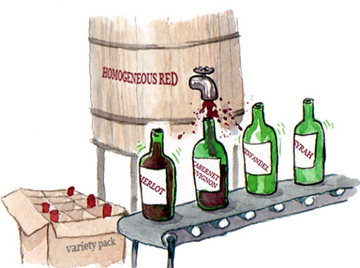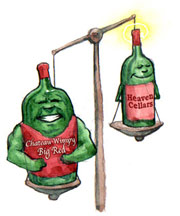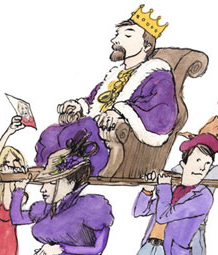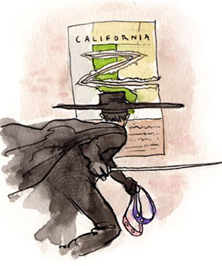

Winemaking trends of the day seem to be leading to increased homogeneity and sameness, and wines that
are varietally indistinguishable.
Varietal Homogenization:
Difference Makes the Difference
Have American wineries become so enslaved to marketing formulas that the wines they make from various varietals taste indistinguishable from each other?
Our informal test points to some loss of individuality of wines.
by
Roger Dial
August 7, 2007
As a media platform, APPELLATION AMERICA’s avowed mission is to encourage and articulate the amazingly rich geographic diversity of the wines of North America. We believe that the “place paradigm” of wine appreciation offers the best vehicle for vitalizing and expanding the North American wine culture in the decades to come. Our motto proclaims our purpose: Building Appellation Consciousness.
Having said that, it must be recognized that another paradigm of wine appreciation (varietalism) holds the centre stage today in North America, and has in fact expanded outwards to much of the rest of the New World. Indeed, the varietal paradigm of wine appreciation has even made incursions into parts of the old wine world, where “place” (aka: appellation) has long been the anchor of consciousness about wine.
As it happens, I was a young winery apprentice (aka cellar rat) when the paradigmatic shift to varietalism began to take hold in California in the 1960s. It was out with the bogus Burgundy labels and in with the Pinot Noir imprint; sayonara plagiarized Chablis, welcome Chardonnay. The transformation around the notion of grape variety was really an epiphany, energized by a palpable sense of the moral superiority that comes with acts of purity. We were being liberated from the lie of phony European nomenclature. Know thy wine by its grape name.
And, as for all that so-called Claret we were producing in California in those days, henceforth it would be known as Cabernet Sauvignon. It was really in the purge of Claret that our Puritanism reached full fervor. This was convenient, because in fact there was no Merlot, Cabernet Franc, Malbec, or Petite Verdot planted in California to make good on the Claret blend claim in the first place. Nor should grapes be mixed, we figured, at least outside the viticultural mélange of Bordeaux, with its iffy climate and irregular vintages that made it risky to depend on a single variety.
Yes, varietal purity reached its zenith in the isolation of Cabernet Sauvignon in California, and was icon-ized in our friend Joe Heitz’s uncompromising Martha’s Vineyard Cabs of the 1970s. God help the winemaker who might have been tempted to cut the tannic purity of Cabernet with a dose of flabby Carignan, as had been common practice. In the new world of varietalism, that would have been a double sin, because Carignan belonged in its own bottle, labeled properly as Carignan! Ditto for Petite Sirah, Barbera, Zinfandel, Gamay, Colombard, Semillon, Green Hungarian, Chenin Blanc, and a host of differentiated Rieslings (Grey, Franken, Johannisberg…even Emerald). For producer and consumer, alike, those were the heady days of varietal exploration, before the arrival of the 3-tier marketing reductionism into a narrow Chard-Cab consumer pipeline.
In the development of most things (material, intellectual, even spiritual), differentiation is typically the signal of change, transformation, expansion and - dare I say it - progress. Inversely, homogenization, the drive toward sameness, bespeaks integration, consensus and stability. If differentiation inspires human interest and passion, what then does homogeneity lead to? Comfort? Boredom?
I think the answer is both: comfort and boredom, but not necessarily for the same cultural audience. In theatre, for example, there will always be an audience for Cats, precisely because the script, music and production values remain, dependably, the same. It may be an audience that never sees other plays (except perhaps Cats II), but that’s fine; they’re comfortable with it, and, to be sure, so is the theatre “industry”.
To be sure, the traditional wine-as-food people, God love’em, do exist here as a relatively small niche and have been served extremely well for years by that affable icon of unassuming disinterest, Carlo Rossi™. In my more hopeful moments, I think the wine-as-food segment may be finally growing significantly …really, a matter of breaking through the latent prohibitionism embedded in our political culture. On the supply side, the emerging “wine-as-food” segment is being drawn out by grocery store merchandizing, notably for Aussie and South American producers of “sweet spot” wine, manufactured out of interchangeable red varieties. And, let’s not overlook the Two-Buck-Chuckers right here in the neighborhood. The fact that Cabernet, Merlot and Syrah are indistinguishable in these prod
Having said that, it must be recognized that another paradigm of wine appreciation (varietalism) holds the centre stage today in North America, and has in fact expanded outwards to much of the rest of the New World. Indeed, the varietal paradigm of wine appreciation has even made incursions into parts of the old wine world, where “place” (aka: appellation) has long been the anchor of consciousness about wine.
As it happens, I was a young winery apprentice (aka cellar rat) when the paradigmatic shift to varietalism began to take hold in California in the 1960s. It was out with the bogus Burgundy labels and in with the Pinot Noir imprint; sayonara plagiarized Chablis, welcome Chardonnay. The transformation around the notion of grape variety was really an epiphany, energized by a palpable sense of the moral superiority that comes with acts of purity. We were being liberated from the lie of phony European nomenclature. Know thy wine by its grape name.
And, as for all that so-called Claret we were producing in California in those days, henceforth it would be known as Cabernet Sauvignon. It was really in the purge of Claret that our Puritanism reached full fervor. This was convenient, because in fact there was no Merlot, Cabernet Franc, Malbec, or Petite Verdot planted in California to make good on the Claret blend claim in the first place. Nor should grapes be mixed, we figured, at least outside the viticultural mélange of Bordeaux, with its iffy climate and irregular vintages that made it risky to depend on a single variety.
Yes, varietal purity reached its zenith in the isolation of Cabernet Sauvignon in California, and was icon-ized in our friend Joe Heitz’s uncompromising Martha’s Vineyard Cabs of the 1970s. God help the winemaker who might have been tempted to cut the tannic purity of Cabernet with a dose of flabby Carignan, as had been common practice. In the new world of varietalism, that would have been a double sin, because Carignan belonged in its own bottle, labeled properly as Carignan! Ditto for Petite Sirah, Barbera, Zinfandel, Gamay, Colombard, Semillon, Green Hungarian, Chenin Blanc, and a host of differentiated Rieslings (Grey, Franken, Johannisberg…even Emerald). For producer and consumer, alike, those were the heady days of varietal exploration, before the arrival of the 3-tier marketing reductionism into a narrow Chard-Cab consumer pipeline.
Viva La Difference – California Wines of Yesterday
The early days of varietal elaboration and exploration made for an exciting wine culture on this continent. As consumers, it was the differences between varieties that catalyzed our interest and spawned our passions. And, for the legions of aspiring new winegrowers/producers that ballooned the ranks of the American wine industry through the 70s, 80s and 90s, the chase was on to expand the differences between wines by expanding the North American viticultural catalogue to include every grape variety under the sun. After all, America has a special place under the sun.In the development of most things (material, intellectual, even spiritual), differentiation is typically the signal of change, transformation, expansion and - dare I say it - progress. Inversely, homogenization, the drive toward sameness, bespeaks integration, consensus and stability. If differentiation inspires human interest and passion, what then does homogeneity lead to? Comfort? Boredom?
I think the answer is both: comfort and boredom, but not necessarily for the same cultural audience. In theatre, for example, there will always be an audience for Cats, precisely because the script, music and production values remain, dependably, the same. It may be an audience that never sees other plays (except perhaps Cats II), but that’s fine; they’re comfortable with it, and, to be sure, so is the theatre “industry”.
The mass-market magic is in the sauce, not in the varietal. And that’s just fine!
Like most of my contemporaries in the wine culture, over the past 40+ years I have been intermittently hopeful and depressed about prospects for the expansion of a European style “wine-as-food” segment of our North American wine culture. This would be your Cats-type audience for wine, a mass of everyday wine consumers who are simply comfortable with the sameness of their daily wine fare. They are not “interested” in wine, per se, any more than they are interested in bread or cornflakes or eggs. To them, wine is just a food group, part of their diet. Let’s not confuse these people with the new foodies, who are terribly interested in what they put in their mouths and for some reason care if the egg came from a free-range chicken or whether the cornflakes have had their genes diddled. As for wine, the new foodies are driven by a thirst for knowledge and new experiences, not just something to quench the other kind of thirst. New foodies are diversity seekers, ever looking to differentiate their experiences, including their encounters with wine.
To be sure, the traditional wine-as-food people, God love’em, do exist here as a relatively small niche and have been served extremely well for years by that affable icon of unassuming disinterest, Carlo Rossi™. In my more hopeful moments, I think the wine-as-food segment may be finally growing significantly …really, a matter of breaking through the latent prohibitionism embedded in our political culture. On the supply side, the emerging “wine-as-food” segment is being drawn out by grocery store merchandizing, notably for Aussie and South American producers of “sweet spot” wine, manufactured out of interchangeable red varieties. And, let’s not overlook the Two-Buck-Chuckers right here in the neighborhood. The fact that Cabernet, Merlot and Syrah are indistinguishable in these prod













 READER FEEDBACK: To post your comments on this story,
READER FEEDBACK: To post your comments on this story,



